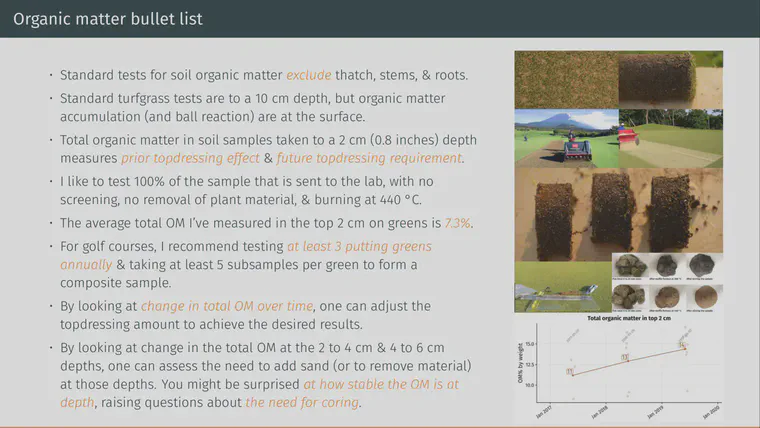Soil organic matter: a bullet list
These are some key things I’ve learned after studying soil organic matter (SOM) for a few years. This is about organic matter in the context of playing conditions—how a ball reacts when it hits the surface. And this is also about the maintenance done to manage organic matter, like sand topdressing, core aerification, and scarification.
Standard tests for soil organic matter exclude undecayed plant material like thatch, stems, and roots. That misses a big chunk of the organic matter that people are trying to measure, and then managing by topdressing, scarifying, or coring.
Standard soil tests for turfgrass sites are to a 10 cm depth, but organic matter accumulation (and ball reaction) are at the surface.
A special test is required to measure total organic material at specific depths. I recommend the international standard: 0 to 2 cm, 2 to 4 cm, and 4 to 6 cm. These depths are more precise than going inch by inch. This is what ATC does with all our clients’ samples at Brookside Labs.
Measuring total organic material in soil samples taken to a 2 cm (0.8 inches) depth provides a useful assessment of prior topdressing effect and of future topdressing requirement. Actually, this is even better than a useful assessment, it is an exact measurement of results.
I find it most effective to test 100% of the sample that is sent to the lab, with no screening, no removal of aboveground plant material, and with a burn at 440 °C.
Measurements I’ve made of total organic material from putting greens, in the top 2 cm, give an average of 7.3%. That’s 73 g of organic matter per 1 kg of sample.
For golf courses, I recommend testing at least three putting greens annually, and taking at least five subsamples per green to form a composite sample.
By looking at change in total OM in the top 2 cm of the rootzone year after year, one can adjust the topdressing amount to achieve the desired results.
By looking at change in the total OM at the 2 to 4 cm depth, and at the 4 to 6 cm depth, one can assess the need to add sand (or to remove material) at those depths.
I’m sure that by looking at total OM over time, you’ll find this to be incredibly useful.

For more information about this important topic, please have a look at:
- One simple trick to transform greens
- Measuring organic matter
- Total organic matter sample number and sample volume
- Three reasons for expressing sand topdressing amount as a depth
- Video about a continuous improvement system that includes OM measurement
- From Charles Henderson at ETL, relating greens organic matter to the amounts of sand applied
- Also from ETL, organic matter testing, part one